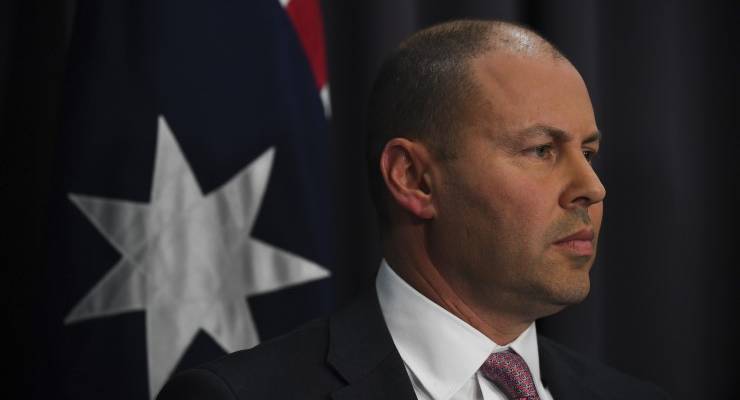
Did you know that Australia is in recession? Apparently we’re in recession. The treasurer said so. The economy contracted in the March quarter, and that means we’re going to be in recession because the economy is contracting this quarter too. That’s a recession.
If anyone was unaware that the economy had contracted as a consequence of shutting much of it down due to a pandemic, the media made sure they knew with a unified shriek about “recession” yesterday in the wake of the March GDP figures showing a 0.3% contraction before the really serious lockdown measures started — although that was a solid result compared to other economies.
And if anything would have deterred Australian consumers, just starting to take advantage of the end of lockdown, from spending again, it would have been the media shouting “recession” from every rooftop.
Yes, we’re in the middle of a major contraction, and it has a long way to play out, particularly given how weak the economy was before the pandemic — something much of the media, including the neoliberal cheer squad at the Financial Review, seem to have been reluctant to acknowledge.
And, yes, Josh Frydenberg correctly agreed we were in recession based on what Treasury was telling him about the current quarter; indeed, to say anything else would have been foolish.
But the fixation on yesterday’s historical data and the repeated, almost constant use of the “r” word by the media, will reinforce Australians’ already strong instinct to hunker down and save up, just in case. And as yesterday’s numbers indicate, it’s households’ deep reluctance — and, until recently, inability — to spend that has curtailed growth.
Even so, there was some good news. For the fourth quarter in a row, the current account data revealed another quarterly surplus for the three months to March. In fact the trade performance made the largest contribution to growth, 0.5%.
That was partly thanks to a sharp fall in imports, reflecting not merely a weak overall economy but weak investment. But it was also due to strong exports. And what was impressive is that the March quarter covered the depths of the pandemic and lockdowns in China, our biggest trade partner. The current quarter will, for those exporting to China, be much better.
It seems that commodity exporters like Australia are doing OK in the crisis, while countries whose exports are dominated by manufactures and sophisticated raw materials are doing it tough — the US, UK, Japan and South Korea. Chinese exports remain solid, too, while its imports are doing OK, signalling that the country’s huge domestic demand is holding up.
But it gets better, because the current account data revealed that Australia’s net international investment position (that’s how much we owe the world after assets are deducted from debt) has fallen to its lowest level since 2013: -$808 billion.
While our debt rose $3.8 billion to $1.146 trillion, our holding of offshore assets rose faster, to an all-time high of more than $338 billion, a rise of $105 billion, or nearly a third, on December.
We can thank the low value of the Aussie dollar for most of that, but if you are old enough to remember the hysteria about the current account deficit and “foreign debt” in the 1980s and 1990s (or Peter Costello’s Debt Truck, designed to embarrass the Keating government, until the truck turned out to be imported), it’s a reminder of how silly trends can come and go in economics as much as everywhere else.
Overall, our terms of trade rose 2.9% after the sharp 5.3% slide in the three months to December. It won’t keep up that improvement — not with major services exports like tourism and education smashed by border closures. But Brazil’s worsening pandemic may curb its iron ore exports, helping to push up iron ore prices still further for Australian exporters.
And just keep in mind some other history. While yesterday saw the first quarter of negative growth since 2011 in today’s values, it wasn’t the first reported quarter of negative growth. The September 2016 quarter was initially reported as a fall of 0.5%, but was subsequently revised up to growth of 0.1%.
So it’s possible — though admittedly not likely — that the 0.3% fall in the March quarter could be revised away in the June accounts due in September, or even after that. Wouldn’t all the media outlets yelling “recession” look especially silly if that happened?
What do you make of the hysteria over the “recession”? Let us know your thoughts by writing to letters@crikey.com.au. Please include your full name to be considered for publication in Crikey’s Your Say column.









Hearing Frydenberg’s pressor from yesterday, apparently it is all Labor’s fault.
I suppose we will soon have to put up with the screams of “debt and deficit ” and ‘budget emergency’ from the LNP government and their happy-clappers like Bolt and Hadley et al?
Apparently 7 years is not long enough to “fix” Labor’s economy.
Of course it’s Labor’s fault – they’ve been in office, in not power, for almost 23 of the last 70 years.
We’re in recession? I thought we were in something else, and it was pretty deep.
At the start of the pandemic various finance types we’d never heard of kept popping up outdoing each other with portents of doom. They were the undeclared short seller / bottom feeder types ready to pounce in the midst of a financial downturn. They’ve mostly gone back to ground as markets recover.
The more recent recession clarion calls simply reflect an obvious reality. It’s hardly rocket science to suggest things are bad when millions are suddenly unemployed.
Don’t count your chickens on that market recovery just yet mark. It is at batshit crazy levels.
The recession we are being ordered to have.